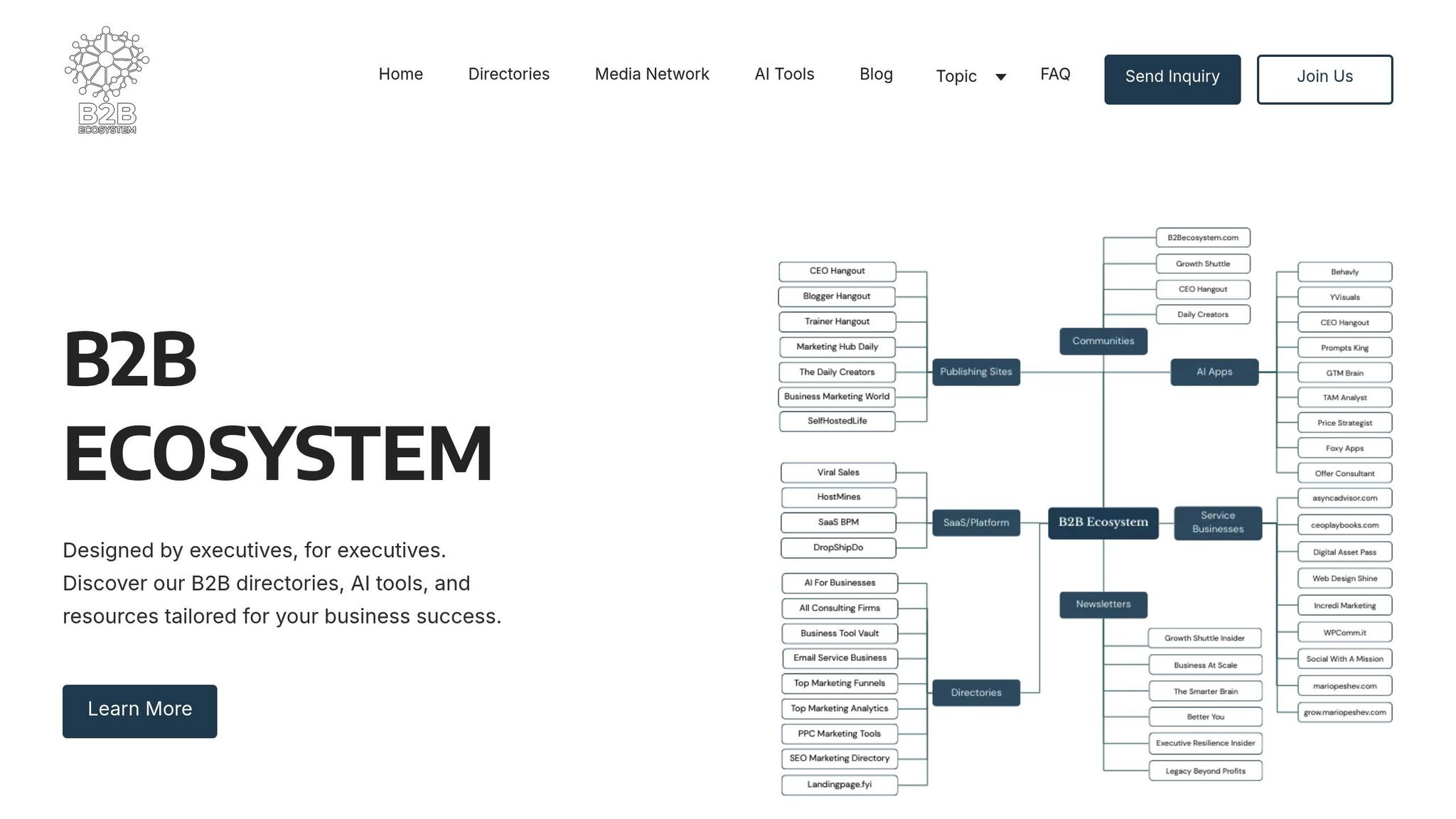Partnerships are the key to staying ahead in competitive markets. Instead of doing everything alone, businesses can collaborate to share resources, reduce risks, and reach new customers faster. This guide breaks down how to build, evaluate, and manage partnerships effectively.
Here’s what you’ll learn:
- Why partnerships matter: 57% of companies gain new customers through collaboration, and partner-driven deals close 46% faster.
- How to find the right partner: Analyze your market, identify gaps, and evaluate potential allies based on shared goals and complementary strengths.
- Steps to success: Use clear agreements, track progress with KPIs, and maintain open communication to ensure long-term growth.
- The role of AI: Tools like predictive analytics and smart contracts simplify partner discovery, performance tracking, and decision-making.
Businesses that focus on partnerships grow five times faster than those that don’t. Ready to strengthen your strategy? Let’s dive in.
Premium Partnership Strategy: Transform Competitors Into Assets
Analyzing the Competitive Landscape
To identify partnership opportunities, start by thoroughly analyzing your competitive environment. This step is key to choosing alliances that strengthen your position in the market. It’s not just about knowing your competitors - it’s about digging into their strategies, uncovering market gaps, and finding partners who can help you gain an edge.
Mapping Your Competitive Environment
Understanding your competitive landscape begins with categorizing your competitors. Group them into direct, indirect, perceived, and aspirational categories. Focusing on up to 10 competitors across these groups keeps your analysis focused and actionable.
Dive into their strategies by studying their websites, marketing efforts, social media presence, and pricing models. Pay attention to their content and how they engage with their audience to understand their brand positioning and target customers. Use tools like SWOT, PEST, and Porter’s Five Forces to structure your analysis and gain a clearer picture of the competitive dynamics.
Historical examples, such as Netflix’s ability to pivot strategically, highlight why staying vigilant in competitive analysis is crucial. This process not only reveals gaps in the market but also uncovers opportunities for strategic partnerships.
Finding Gaps and Partnership Opportunities
Once you’ve mapped the competitive landscape, the next step is identifying where partnerships can fill unmet needs, address technological challenges, or tap into underserved markets. Start by analyzing customer feedback to pinpoint areas where existing solutions fall short. Combine this with market research to track emerging trends, regulatory shifts, and changes in customer expectations that could signal new opportunities.
Conducting a thorough SWOT analysis of competitors can also reveal weaknesses or blind spots - areas where a well-chosen partner could provide a competitive advantage.
"The best partnerships are built on a foundation of complementary expertise - look for partners whose skills, resources, knowledge, and capabilities fill gaps or enhance your own organization." - Nathan Miller, Founder of Rentec Direct
For instance, in 2025, a software company collaborated with nearly 20 tech providers to offer seamless integrations, partnering with specialists in areas like electronic signatures, insurance, tax filing, and mobile property inspections. In another case, the same company worked with a regional healthcare organization to simplify payment processes for landlords when tenants qualified for assistance.
How to Evaluate Potential Partners
Finding potential partners is just the start. A thorough evaluation process ensures your partnerships are built for long-term success. Begin by defining what an ideal partner looks like. Consider factors like industry expertise, alignment with your target market, shared values, and complementary strengths.
Assess potential partners on key criteria such as market opportunity, strategic alignment, relationship strength, revenue potential, and customer compatibility. Don’t overlook financial stability, reputation, intellectual property, and past performance.
"When objectives are not aligned, there was no reason to prioritize a partnership or put any effort behind co-marketing/co-selling with them." - Steve Hellin
Cultural compatibility is just as important. Shared values, business ethics, and communication styles can make or break a partnership. Observing how potential partners handle their existing relationships can provide valuable insights.
"Buyer persona is a huge one because if both technologies are not speaking with the same buyer persona, it could get tricky." - Samantha Samuels
Before committing to a major partnership, test the waters with smaller collaborative projects. These trials can reveal how well your teams work together and highlight any potential friction points.
"I like to monitor, get feedback, and make an assessment of how the teams are working with one another. Simply put – does the partner like working with my team and vice versa?" - Maurits Piper
Use tools like the SCOPE framework (Scale, Champion, Objectives, Proposition, and Executive Stakeholder) to systematically evaluate partners and ensure alignment with your goals. Conduct due diligence on their operations, finances, and legal compliance to minimize risks.
Companies that implement structured evaluation processes have reported impressive benefits, including up to a 32.3% increase in sales within the first year.
Building Effective Partnerships
Turning opportunities from a competitive analysis into successful alliances requires clear frameworks, structured agreements, and effective management. By carefully selecting partners and building strong relationships, businesses can create partnerships that drive mutual success.
Frameworks for Partner Selection
Choosing the right partner is crucial - making the wrong choice can lead to setbacks. Start by evaluating your own strengths and weaknesses. This self-assessment helps identify the traits you need in a partner to complement your capabilities.
When selecting a partner, consider these key factors:
- Strategic alignment: Your partner's goals should align with yours, and their market position should enhance your competitive edge.
- Complementary resources: Focus on combining unique strengths rather than duplicating efforts.
- Financial stability: A partner with steady finances and a willingness to invest is critical.
- Cultural alignment: Shared values, ethics, and communication styles are essential.
- Industry experience: Partners with relevant expertise can help navigate common challenges.
- Trustworthiness: Confidence in your partner's integrity is non-negotiable.
A systematic evaluation process that examines operational compatibility, commitment levels, and risk management strategies ensures you’re making informed decisions. Once you’ve identified the right partner, formalize the relationship with structured agreements.
Structuring and Negotiating Partnership Agreements
A strong partnership starts with a clear, mutually beneficial agreement. Begin by defining the partnership’s purpose, goals, and the contributions each party will make. Include details like financial investments, intellectual property, and management responsibilities. Specify how profits and losses will be shared, and establish a plan for handling disputes through mediation or arbitration.
"Win-win relationships come from a position of trust. They are fostered from an environment of communication, transparency, authenticity and similar long-term goals."
- Sara Roberts, Founder
To protect sensitive information, include non-compete and confidentiality clauses. Plan for the future by outlining exit strategies, such as how a partner can leave, how their share will be valued, and how assets will be divided. Knowing your deal breakers and clarifying ownership of all property upfront can prevent conflicts later.
"Balance the terms and conditions, as partnerships are a 2-way street. Give and get, this is the way ahead."
- Sanjay Dukle, Strategic Partnerships Mentor
Agreements should also include flexibility to adapt to changing conditions. For example, establish Service-Level Agreements (SLAs) that define performance expectations and accountability, with provisions for scaling as the partnership grows. Once the agreement is in place, the focus shifts to managing and growing the partnership.
Managing and Scaling Partnership Operations
Successful partnerships require ongoing attention, clear communication, and adaptability. Businesses that collaborate effectively with external partners can experience up to 19% higher revenue growth compared to those that don’t.
Communication and trust are the foundation of any strong partnership. Prioritize open communication, emotional intelligence, and consistent engagement to maintain trust. Since trust breakdowns account for 60% of failed business relationships, it’s essential to nurture this aspect.
Regularly review the partnership’s performance against established goals. Use clear KPIs to track progress and identify areas for improvement. Address challenges early to keep the relationship productive.
Real-world examples highlight the power of effective partnership management. Starbucks partnered with PepsiCo to expand into the ready-to-drink coffee market, leveraging PepsiCo’s distribution network to boost revenue and market presence . Similarly, Spotify and Uber collaborated to let passengers personalize their rides with music, enhancing user engagement and loyalty . Another example is Cisco and Microsoft, which combined their software and hardware solutions to offer comprehensive cloud and networking services, increasing market share for both.
Scaling partnerships requires adaptability as business needs evolve. Build flexibility into your agreements and implement tools like collaborative technologies to keep operations aligned. Celebrate milestones to foster mutual respect and maintain momentum. Acknowledging successes while addressing challenges ensures the partnership remains strong.
Investing in training and skill development for partners strengthens the alliance and enhances capabilities. Treat your partner relationships with the same care as your internal teams.
"Partnerships have a way of transforming the impossible into the possible by leveraging the strengths of groups and organizations for public good."
- Kimberly Sinclair-Holmes, Assistant Director, Alabama Cooperative Extension System
Partnerships thrive with consistent care. Regularly revisit goals, celebrate achievements, and tackle challenges as they arise.
sbb-itb-01010c0
Using Technology to Improve Partnerships
Modern technology has completely reshaped how businesses find, evaluate, and manage partnerships. Tasks that once took weeks of manual effort are now streamlined through AI-powered tools and data analytics platforms. These advancements have become essential for businesses looking to stay competitive in today’s fast-paced markets. Let’s dive into how AI is revolutionizing the way companies discover and manage partnerships.
Using AI and Automation for Partner Discovery
AI has taken the guesswork out of finding the right partners. Instead of spending hours - or even days - on manual searches, businesses can rely on AI tools to automate the entire process. These tools quickly identify and prioritize potential partners based on specific criteria, scan the web and social media for insights, and even send personalized outreach emails tailored to a prospect’s interests and business goals. This not only saves time but also improves accuracy. For example, traditional influencer research can take up to 40 hours a week, and 61% of marketers report that identifying the right partners is one of their biggest challenges.
AI doesn’t stop at discovery; it also makes managing partnerships easier. From automating the creation and updating of agreements to assigning responsibilities and generating smart contracts, AI reduces administrative burdens. These smart contracts can even track and enforce terms automatically, improving communication and data security.
"AI tools can really help smaller partner teams with activities like partner enablement content, images, FAQs based on internal knowledge bases and brainstorming ideas for co-marketing activities." - Juhi Saha, Your Partnerships Copilot
Companies are already leveraging AI to transform their operations. For instance, in March 2025, HCLTech announced a multi-year partnership with OpenAI to integrate AI models into its services and internal operations. By adopting tools like ChatGPT Enterprise, HCLTech demonstrated how AI can enhance both external client relationships and internal efficiency.
AI also plays a key role in analytics, aggregating data from multiple sources to evaluate performance metrics and generate detailed reports. These insights help businesses forecast revenue growth and make informed strategic decisions. With AI-driven influencer marketing expected to grow by 30% in the coming year, it’s clear that similar trends are shaping partnership strategies across industries.
Data-Driven Decision-Making in Partnerships
Gone are the days when decisions were made purely on intuition. Data analytics has transformed partnership management, enabling businesses to optimize their strategies, allocate resources wisely, and anticipate market shifts. Companies that rely on data-driven approaches consistently outperform those that don’t. For example, only 40% of top-performing businesses make decisions based on gut instinct, compared to 70% of underperforming ones.
Predictive analytics takes this a step further by helping companies forecast trends, evaluate the potential success of partnerships, and address conflicts before they arise. A growing number of marketers - 82%, to be exact - plan to increase their use of first-party data from sources like CRM platforms, web analytics, and mobile apps, signaling a strong shift toward evidence-based strategies.
Major organizations are already using predictive analytics to streamline their decision-making and improve performance. Transparent reporting ensures that all partners have access to the same data, fostering collaboration and trust. These tools lay the groundwork for integrated platforms that further simplify partnership management.
How The B2B Ecosystem Tools Support Partnership Management

The B2B Ecosystem offers a suite of tools designed to make partnership management more efficient and transparent. Its Collaborative Outcome Ecosystems (COE) focus on tracking partner contributions and ensuring fair compensation. Here are some key features:
| Feature | Description |
|---|---|
| Distributed Ledger Technology | Securely records transactions for transparency |
| Smart Contracts | Automates collaboration terms, outcome metrics, and compensation |
| Tokenization of Value | Tracks contributions with tokens that can be exchanged |
| Real-time Value Tracking | Monitors partner contributions continuously through APIs |
| Private Channels | Provides secure communication for sensitive information |
| Governance Framework | Allows decentralized decision-making among partners |
The platform also includes advanced AI tools. For example, the GTM Brain delivers go-to-market strategy assessments, while the TAM Analyst breaks down market opportunities. The Price Strategist provides insights into competitor analysis and conversion optimization, helping businesses strengthen their market position.
These tools have real-world applications. For instance, a COE focused on digital transformation might bring together cloud service providers, cybersecurity experts, and AI-driven analytics firms. The platform would track each partner’s contributions and ensure fair compensation based on measurable outcomes. Similarly, customer experience partnerships - combining CRM software, natural language processing tools, and communication platforms - can use the system to track metrics like customer satisfaction and response times.
"The outcome the customer gets is more than they would if they were dealing with us independently." - Denise Millard, Chief Partner Officer at Dell Technologies
Another example includes data-focused COEs, where data storage providers, machine learning experts, and visualization specialists work together. The platform’s analytics tools turn raw data into actionable insights, tracking metrics like data processing volumes and predictive model accuracy.
The potential for these ecosystems is enormous. McKinsey estimates that by 2025, ecosystem business models could account for $60 trillion - 30% of the global economy. The B2B Ecosystem’s directories further enhance partner discovery by offering a comprehensive database of potential collaborators, while its consulting services help businesses develop and implement effective strategies.
"When designing a partner program, you need to start by understanding what's most important to your partners and build the program around that." - Kate Woolley, IBM Ecosystem General Manager
With features like interoperability for seamless integration with enterprise systems and consensus mechanisms for validating transactions, The B2B Ecosystem supports the complex coordination required for successful partnerships. By turning data insights into actionable strategies, businesses can strengthen their collaborations and remain competitive in rapidly evolving markets.
Key Takeaways for Competitive Partnerships
Competitive partnerships have become a cornerstone of B2B growth. Companies that adopt and refine these strategies can unlock accelerated revenue growth and gain an edge in increasingly complex markets. Here’s how to make the most of partnership opportunities.
The Value of Partnerships in Competitive Markets
Did you know that companies with robust partner ecosystems grow five times faster than those without? Plus, 76% of executives believe partnerships are critical to hitting revenue goals. When partners are involved, deals close 46% faster, and opportunities are 53% more likely to succeed. And it doesn’t stop there - partner-driven deals boast a 40% higher average order value, while 72% of businesses report lower customer acquisition costs through partnerships.
Take Microsoft, for example. Over 95% of its revenue comes from its partner network. This dependence on partnerships not only diversifies revenue streams but also opens doors to new markets.
"Great things in business are never done by one person; they're done by a team of people." - Tim Cook, CEO of Apple
As 76% of business leaders identify ecosystems as the primary disruptor in their industries, delaying partnership initiatives could leave companies lagging behind in a world increasingly shaped by interconnected business models.
Action Steps to Build and Manage Partnerships
Building effective partnerships requires a clear and structured approach. Start by defining shared objectives like customer acquisition, revenue growth, or market expansion. Establish transparent processes to align teams and maintain consistent communication throughout the customer journey. Frequent check-ins and open dialogue build trust and ensure that everyone stays focused on the end goal. Use data to measure partner performance and refine strategies as needed.
Focus on relationships that offer high potential. Choose partners who share your values and are committed to creating mutual benefits. Understanding your company’s role in the ecosystem - whether you’re the “star” or the “planet” - can help you allocate resources and set priorities effectively. Use key performance indicators (KPIs) to guide each phase of the partnership, from recruitment and enablement to lead generation and transactional milestones.
Diversity in partnerships also pays off. Expanding your network with varied tech partners can spark innovation, open new markets, and keep your solutions relevant. To add a fun twist, consider gamifying collaboration between partners and sales teams to boost engagement and motivation.
Using The B2B Ecosystem for Partnership Success
Digital platforms can take your partnership strategy to the next level. For instance, the B2B Ecosystem offers AI-powered tools designed to streamline and enhance collaboration. Its discovery feature can match your company with over 10,000 potential partners, drastically cutting down the time spent on manual research. Other tools, like the GTM Brain and TAM Analyst, provide go-to-market strategy insights and detailed market breakdowns, helping you identify and seize new opportunities. The Price Strategist tool, meanwhile, delivers competitor analysis and conversion optimization tips to strengthen your negotiation and market positioning.
The platform also includes comprehensive directories of potential collaborators and consulting services to help you build and refine your strategies. With ecosystem business models projected to account for $60 trillion - 30% of the global economy - by 2025, leveraging these resources is becoming more critical than ever. Advanced analytics further transform data into actionable insights, allowing for continuous improvement.
To thrive in competitive partnerships, you need both a solid strategic framework and cutting-edge technology. Companies that combine these elements effectively are better equipped to harness the full potential of modern partnership ecosystems. By acting on these insights and utilizing digital tools, you can stay ahead in the ever-evolving B2B landscape.
FAQs
How can AI and automation simplify and improve business partnerships?
AI and automation are reshaping the way businesses manage partnerships by taking over time-consuming tasks like data entry and partner onboarding. By handling these repetitive processes, companies can save both time and resources while focusing on more strategic activities.
These technologies also bring predictive analytics into the mix, helping organizations pinpoint promising partners, evaluate compatibility, and even predict potential outcomes. This means decisions are no longer based on guesswork but on solid, data-driven insights.
On top of that, AI tools enhance communication and collaboration by automating workflows, monitoring performance metrics, and delivering real-time updates. This keeps partnerships running smoothly and aligned with business goals, creating stronger and more efficient working relationships.
What should I look for when choosing a long-term business partner?
When choosing a long-term business partner, it’s essential to prioritize shared goals, trust, and financial stability. A partnership thrives when both parties are aligned in their vision and values, creating a foundation for a productive working relationship.
Take the time to assess their reputation, how they communicate, and how they handle change. A thorough evaluation of these factors can help ensure your partnership is built to last and capable of navigating challenges effectively.
What are the best ways for businesses to build trust and maintain clear communication in partnerships?
To create strong partnerships, businesses should focus on open and clear communication. This means setting clear expectations, actively listening, and encouraging regular, honest discussions. Personal interactions, like in-person meetings or video calls, can go a long way in building stronger connections and fostering mutual understanding.
Maintaining trust requires consistency and integrity. Always honor commitments and address concerns as soon as they arise. Being mindful of cultural differences and showing respect for them also helps create a more inclusive and cooperative environment, minimizing misunderstandings and avoiding potential conflicts.


